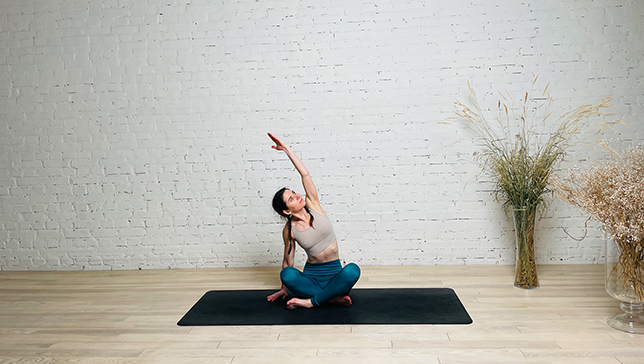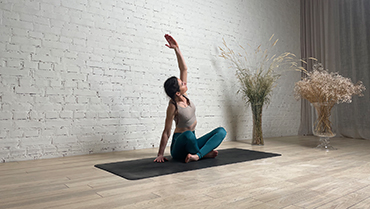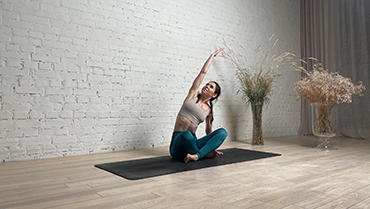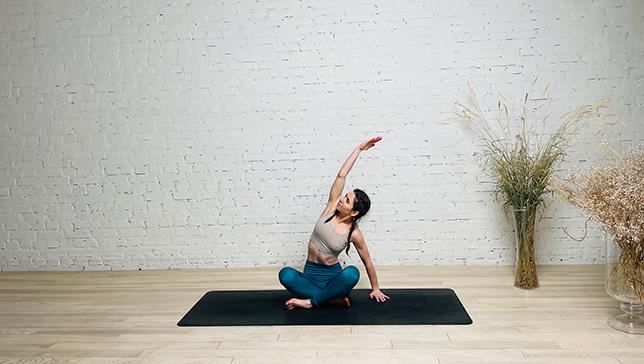Seated Side Bend Pose - Parsva Sukhasana

Contents
Seated Side Bend Pose or Parsva Sukhasana (PA-AAr-svA SOOkas-ana) is a variation of Sukhasana (Easy Pose). Seated Side Bend is a simple seated posture which is commonly used in yoga to warm up the body. This posture opens the hips and provides a lateral twist; therefore, it is beneficial for the lower and upper back, chest and psoas muscle. Energetically, Parsva Sukhasana calms and grounds as well as awakens the heart.
Parsva Sukhasana (Seated Side Bend) Affects the 3 Doshas.
- Vata: Seated Side Bend Pose is a wonderful way to restore a grounded, rooted energy to the often highly mobile, variable energy of Vata dosha. Since the low body is supported by the floor in this posture, apana vayu, the downward moving energy needed for healthy, regular bowel movements is also enhanced.
- Pitta: Parsva Sukhasana provides pitta types the opportunity to slow down, simplify and cultivate waves of calm and bliss in both their bodies and minds. As the side body opens and stretches in this posture, the organs of digestion are able to expel any unwanted toxins and excess heat, ultimately relieving the fiery nature of pitta dosha.
- Kapha types: Seated Side Bend Pose expands the side body, opens the heart center and liberates the organs of respiration. The focus for kapha types in this posture is to take gobs of full breaths in and out to stretch and expand the upper body, in order to rid the body and mind of congestion, lethargy and sluggishness.
Pose Detail
- Difficulty: Beginners
- By Type: Flexibility Yoga Poses, Hip Opening Yoga Poses, Restorative Yoga Poses, Shoulder Opening Yoga Poses, Strengthening Yoga Poses
- Body Position: Lateral Bend Yoga Poses, Seated Yoga Poses
- By Benefit: Yoga Poses For Stress Relief
Step-by-Step Instructions
Benefits and Contraindications
Severe arthritis in the knees
Recent shoulder surgery
Severe shoulder pain
Sciatica
Recent knee replacement surgery
Severe lower back pain
High blood pressure
Dizziness
Hip joint pain
Pain in knees or knee arthritis
Photo poses in different angles



Modifications, Props and Tips
- Avoid twisting the spine by opening the chest and drawing the shoulder of the top arm back.
- It’s best to practice this pose sitting on the edge of a cushion or a rolled blanket. This will make it much easier to keep your back straight.
- Instead of going to the deepest variation right away, take it slow and in stages. Use your breath to guide you – On each inhale expand the chest, and with each exhalation lengthen and deepen the stretch more.
Seated Side Bend Pose Anatomy
Seated Side Bend Pose primarily targets the side body, including the intercostal muscles, obliques, and quadratus lumborum. Here’s a breakdown of the anatomy involved in this pose:
- Intercostal muscles: These muscles are located between the ribs and are responsible for the movement of the ribcage during breathing. In Parsva Sukhasana, the intercostal muscles on the side of the bend are stretched and lengthened.
- Obliques: The oblique muscles are located on the sides of the abdomen and are responsible for lateral flexion and rotation of the trunk. The external obliques are particularly engaged in Parsva Sukhasana as they help to move the torso to the side.
- Quadratus lumborum: This muscle is located in the lower back and helps to stabilize the lumbar spine. It is activated in Parsva Sukhasana to maintain an upright posture and prevent excessive rounding or arching of the back.
- Spine: The spine is also involved in Parsva Sukhasana, as it is lengthened and stretched to the side. The side bend can also help to increase the mobility of the spine and alleviate stiffness.
- Additionally, the pose can also provide a stretch for the hip flexors and the gluteus medius on the side of the bend. It’s important to maintain proper alignment and engage the core muscles to protect the lower back and maintain stability throughout the pose.
Frequently Asked Questions
Variations
- Easy Pose
- Seated Side Bend With A Strap
- Seated Side Bend On A Chair
Top Preparatory Pose
- Easy Pose
- Seated Cat Cow Pose
- Cow Face Pose
Top Follow-Up Pose
- Seated Mountain Pose
- Seated Spinal Twist
- Half Lord Of The Fishes Pose
- Revolved Seated Wide Angle Pose